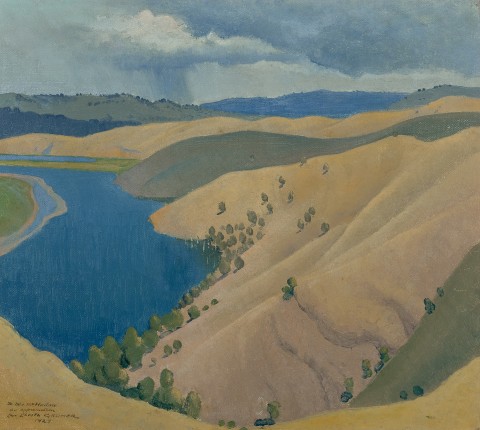ROLLING HILLS, YASS, 1929
ELIOTH GRUNER
oil on canvas
41.0 x 46.5 cm
signed, dated and inscribed lower left: To Mr. & Mrs. Wallace/an appreciation/from ELIoth GRUNER/1929
Mr and Mrs Wallace, New South Wales
Leonard Joel, Melbourne, 2 – 3 November 1988, lot 105 (as ‘Rolling Hill, Yass’)
Bridget McDonnell Gallery, Melbourne (label attached verso)
Joseph Brown Gallery, Melbourne
The Cbus Collection of Australian Art, Melbourne, acquired from the above on 10 October 1990
Exhibition of Australian Paintings, Earl Gallery, Melbourne, n.d., cat. 21 (illus. in exhibition catalogue)
Early Australian Paintings, Bridget McDonnell Gallery, Melbourne, 11 – 30 September 1990, cat. 11 (illus. in exhibition catalogue)
The Bus Collection of Australian Art, Wollongong City Gallery, New South Wales, 16 March – 12 April 1992, cat. 17
Dawn to Dusk: Landscapes from the Cbus Collection of Australian Art, Latrobe Regional Gallery, Victoria, 31 May – 16 Nov 2014
Colour and Movement, Benalla Art Gallery, Victoria, 19 February – 9 June 2016
Figures and Landscapes, Latrobe Regional Gallery, Victoria, 16 December 2017 – 11 March 2018
on long term loan to Geelong Art Gallery, Victoria
Nainby, B., Stanhope, Z., and Furlonger, K., The Cbus Collection of Australian Art, in association with Latrobe Regional Gallery, Melbourne, 2009, pp. 14 (illus.), 220
Rolling Hills Near Yass, 1929, oil on canvas, 51.4 x 61.2 cm, in the collection of Queensland Art Gallery, Brisbane, Gift of the Queensland Art Fund 1931
The paintings created by Elioth Gruner of the Ngunnawal lands around Yass in the mid-west of New South Wales are amongst his most celebrated. As curator Deborah Clarke notes, these images marked ‘the high point of his progression towards creating modern landscape.’1 The major work from the sequence, On the Murrumbidgee, 1929 (Art Gallery of New South Wales), shows the sinuous river of the title winding through the hills and valleys with such immediacy that it is little surprise that the painting was awarded the Wynne Prize, Gruner’s fourth such win.2 Rolling Hills, 1929, is more intimate and focusses on one bend of the Murrumbidgee with a further glimpse of the water continuing above after negotiating a horseshoe bend that lies out of sight to the left. This is the preliminary plein air study that Gruner executed on site before painting the slightly larger Rolling Hills near Yass, now in the collection of the Queensland Art Gallery. Giving an ‘almost aerial view of steep dry rocky slopes that appear to be carved out of the landscape’,3 Rolling Hills provides a clear illustration of Gruner’s assured technique as he captures a scene contrasting the sloping lands cleared for sheep with the surviving trees gathered at the lower fringe. Others grow scattered elsewhere on the denuded flanks, whilst dead trunks emerge from the water’s edge. Above is a blustery sky full of shifting clouds and the sense of a fresh country day is palpable.
The 1920s had been a testing period for Gruner during which his art adopted elements of modernism’s flattened space and focus on design resulting from his encounter in London with the artist Sir William Orpen who was openly critical of the Australian’s work. His modest adoption of these more contemporary techniques led to further criticism from his former colleagues, particularly Norman Lindsay, who detested all modern art. Gruner was, by temperament, a loner and this hostility and self-doubt led to him having a breakdown in 1927 triggered further by alcoholism and depression. One step towards his recovery was the purchase of a Model A Ford in which he began to travel widely, vastly improving his outlook and sense of purpose. Gruner first visited the Yass region in 1928 and revisited repeatedly in subsequent years, depicting ‘the ancient hills as broad simple masses pushed up from the river valley and arranged in undulating rhythms across the picture plane.’4
1. Clark, D., Elioth Gruner: Texture of light, Canberra Museum and Gallery, ACT, 2014, p.12
2. Gruner won the Wynne Prize a record seven times: 1916, 1919, 1921, 1929, 1934, 1936 and 1937
3. Clark, ibid.
4. ibid.
ANDREW GAYNOR
